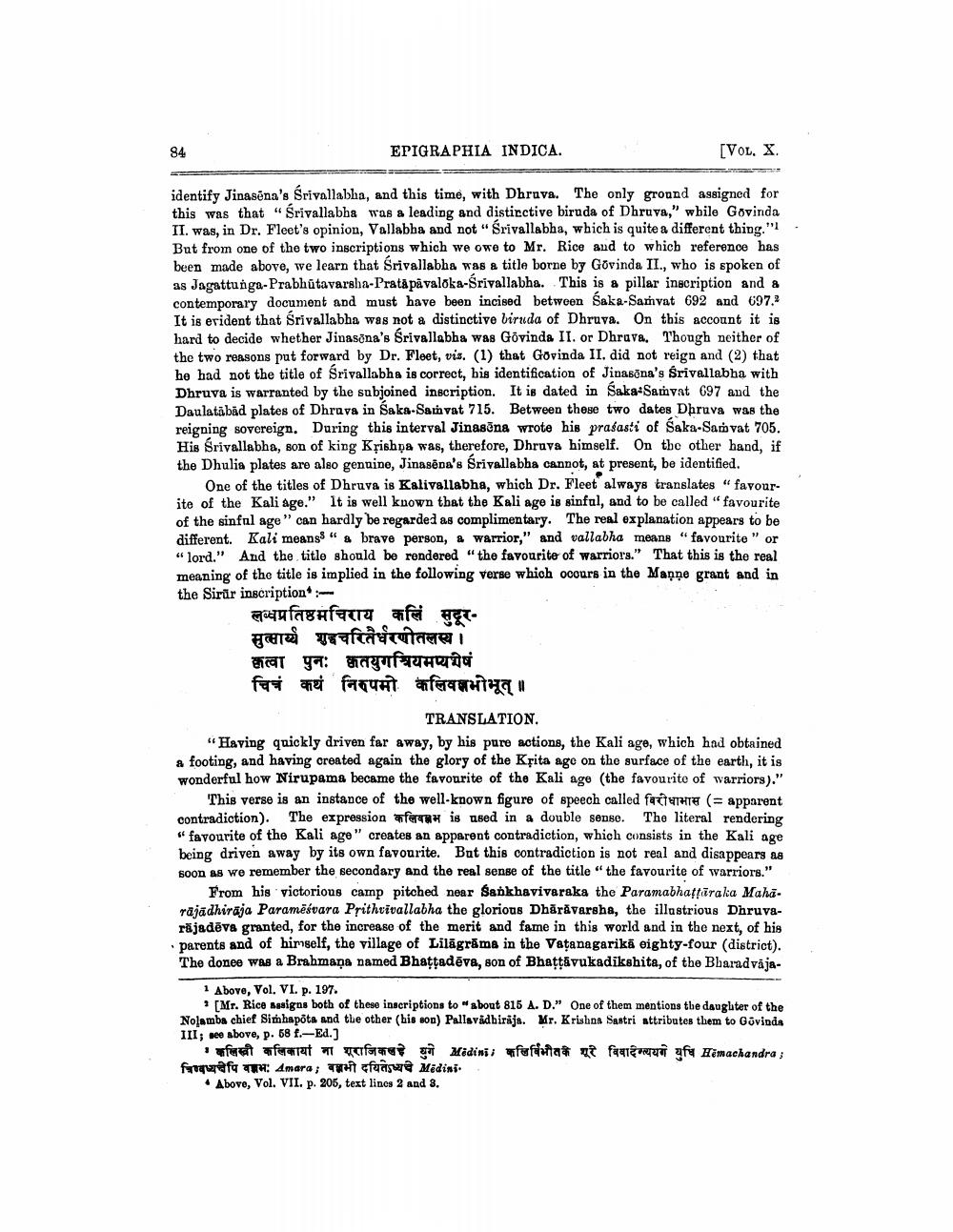________________
EPIGRAPHIA INDICA.
[VOL. X.
identify Jinasena's Śrivallabha, and this time, with Dhruva. The only ground assigned for this was that "Śrivallabha was a leading and distinctive biruda of Dhruva," while Govinda II. was, in Dr. Fleet's opinion, Vallabha and not "Śrivallabha, which is quite a different thing." But from one of the two inscriptions which we owe to Mr. Rice and to which reference has been made above, we learn that Śrivallabha was a title borne by Govinda II., who is spoken of as Jagattunga-Prabhutavarsha-Pratapa valoka-Śrivallabha. This is a pillar inscription and a contemporary document and must have been incised between Saka-Samvat 692 and 697.2 It is evident that Srivallabha was not a distinctive biruda of Dhruva. On this account it is hard to decide whether Jinasõna's Śrivallabha was Govinda II. or Dhruva. Though neither of the two reasons put forward by Dr. Fleet, vis. (1) that Govinda II. did not reign and (2) that he had not the title of Śrivallabha is correct, his identification of Jinasõna's Śrivallabha with Dhruva is warranted by the subjoined inscription. It is dated in Saka-Samvat 697 and the Daulatabad plates of Dhruva in Saka-Samvat 715. Between these two dates Dhruva was the reigning sovereign. During this interval Jinasēna wrote his prasasti of Saka-Samvat 705. His Śrivallabha, son of king Krishna was, therefore, Dhruva himself. On the other hand, if the Dhulia plates are also genuine, Jinasena's Śrivallabha cannot, at present, be identified.
84
One of the titles of Dhruva is Kalivallabha, which Dr. Fleet always translates "favourite of the Kali age." It is well known that the Kali age is sinful, and to be called "favourite of the sinful age" can hardly be regarded as complimentary. The real explanation appears to be different. Kali means " a brave person, a warrior," and vallabha means "favourite" or "lord." And the title should be rendered "the favourite of warriors." That this is the real meaning of the title is implied in the following verse which occurs in the Manne grant and in the Sirür inscription:---
सम्भप्रतिष्ठमचिराय कलिं सुदूरसुसा शुद्धचरितैर्धरणीतलस्य 1
कृत्वा पुनः कृतयुगश्रियमप्यशेषं
चित्रं कथं निरुपमो कलिवज्ञभोभूत् ॥
TRANSLATION.
"Having quickly driven far away, by his pure actions, the Kali age, which had obtained a footing, and having created again the glory of the Krita age on the surface of the earth, it is wonderful how Nirupama became the favourite of the Kali age (the favourite of warriors)."
This verse is an instance of the well-known figure of speech called fat (= apparent contradiction). The expression afera is used in a double sense. The literal rendering "favourite of the Kali age" creates an apparent contradiction, which consists in the Kali age being driven away by its own favourite. But this contradiction is not real and disappears as soon as we remember the secondary and the real sense of the title "the favourite of warriors."
From his victorious camp pitched near Sankhavivaraka the Paramabhaṭṭāraka Mahārajadhiraja Paramesvara Prithvivallabha the glorious Dharavarsha, the illustrious Dhruvarajadēva granted, for the increase of the merit and fame in this world and in the next, of his parents and of himself, the village of Lilagrama in the Vatanagarika eighty-four (district). The donee was a Brahmana named Bhaṭṭadeva, son of Bhaṭṭāvukadikshita, of the Bharadvaja.
1 Above, Vol. VI. p. 197.
[Mr. Rice assigns both of these inscriptions to "about 815 A. D." One of them mentions the daughter of the Nolamba chief Simhapota and the other (his son) Pallavädhiraja. Mr. Krishna Sastri attributes them to Govinda III; see above, p. 58 f.-Ed.]
• कलिस्त्री कलिकायां ना शराजिकल युगे Midini) कलिर्विभीतके शूरे विवादव्ययगे युधि Himachandra त्रिग्वध्यचेपि वज्ञभ: Amara बलभी दयितेऽध्यचे Medini.
4 Above, Vol. VII. p. 205, text lines 2 and 3.




